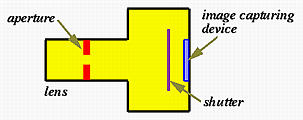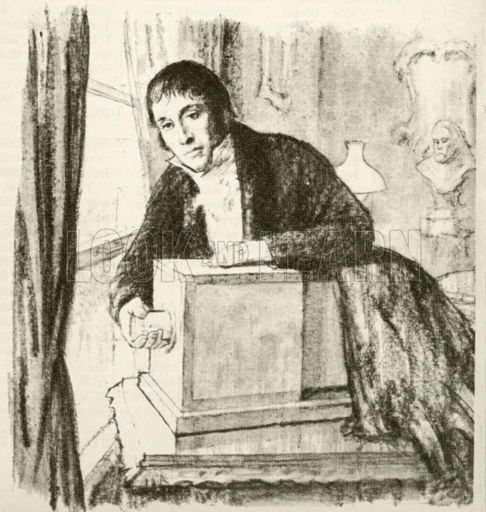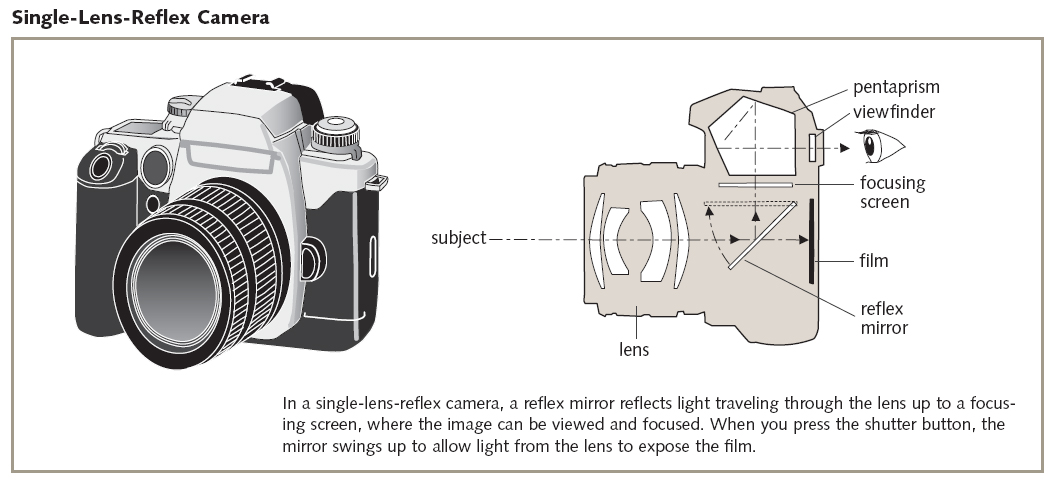

We begin with a light tight box to hold the film and carry it around from subject to subject.
The shutter controls when the light enters the camera and for how long it enters. A good camera will have some way of adjusting the time the shutter is open plus there has to be some type of release for the shutter.
The lens lets in light. The larger the lens the more light. The lens also effects how large the image appears based on the focal length of the lens.
The aperture is located in the lens and is a set of leaf like piece of metal that can change the size of the hole that lets in light. We consider the lens to be part of the shutter as we do not actually need a lens to focus an image if we have a small enough hole to let in the light.
Camera obscura is the natural optical phenomenon that occurs when an image of a scene at the other side of a screen (or for instance a wall) is projected through a small hole in that screen as a reversed and inverted image (left to right and upside down) on a surface opposite to the opening. The surroundings of the projected image have to be relatively dark for the image to be clear, so many historical camera obscura experiments were performed in dark rooms.


The term "camera obscura" also refers to constructions or devices that make
use of the principle within a box, tent or room. Camerae obscurae with a lens in
the opening have been used since the second half of the 16th century and became
popular as an aid for drawing and painting. The camera obscura box was developed
further into the photographic camera in the first half of the 19th century when
camera obscura boxes were used to expose light-sensitive materials to the
projected image.

The camera obscura was used as a means to study eclipses, without the risk
of damaging the eyes by looking into the sun directly.
As a drawing aid, the camera obscura allowed tracing the projected image to produce a highly accurate representation, especially appreciated as an easy way to achieve a proper graphical perspective.
Joseph Nicephore Niepce


A camera obscura device without a lens but with a very small hole is
sometimes referred to as a "pinhole camera", although this more often refers to
simple (home-made) lens-less cameras in which photographic film or photographic
paper is used.
https://www.abelardomorell.net/project/camera-obscura/
Large Format Cameras
.jpg)
A very large camera designed by George R. Lawrence (1868-1938) and used to photograph a train of the Chicago & Alton railroad on the Chicago-St. Louis line for the 1900 Paris Exhibition. - After the French Consul General had inspected the camera and enormous glass plate, Lawrence was awarded the Grand Prize of the World for Photographic Excellence at the Paris Exposition of 1900 for his 8 x 4 1/2 foot photograph of the Alton Limited train, promoted as The Largest Photograph in the World of the Handsomest Train in the World. https://commons.wikimedia.org/wiki/File:The_giant_camera.jpg
Medium Format Cameras
.jpg)
35mm Format Cameras

.jpg)
In an Era where digital cameras come and go quickly, the Leica II from 1932 still works fine and is most definitely fun to use for not so modern photography.
The Leica II was the first commercially successful, small 35mm format, rangefinder camera with a reliable shutter and with a standardized lens mount, which allowed for interchangeable lenses. This was cutting edge technology in 1932. In spite of its age - the Leica II is still a very usable camera for daylight photography. With the collapsible 50mm Elmar lens or 35mm focal length Summaron, the entire Leica II package will comfortably fit in coat pocket.
Mirrorless System Cameras
Stereo Cameras (3-D)
Instant Cameras
Polaroid
https://petapixel.com/2015/06/11/the-history-and-magic-of-instant-photography/
Instax
Lomo'Instant
Instant Film
Other Cameras
Digital Camera

The camera generally recognised as the first digital still snapper was a prototype developed by Eastman Kodak engineer Steven Sasson in 1975.